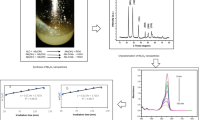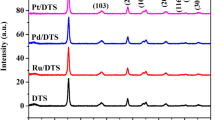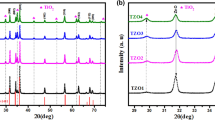Abstract
Commercial TiO2 nanoparticles were superficially modified through polymeric resins obtained from polymerization of citrate complexes of Y3+ and Al3+ with ethylenglycol. The materials were treated at 450 °C for 4 h to obtain modified nanoparticles, which were characterized by HR-TEM, Zeta potential and surface area through N2 fisisorption. Rhodamine B photodegradation by visible light irradiation and in presence of those modified nanoparticles was compared with the same process in presence of unmodified commercial TiO2 nanoparticles. It was observed, by UV–visible spectroscopy, that the catalytic photoactivity in presence of modified nanoparticles was smaller than that observed with commercial TiO2 nanoparticles. However, the surface modifier played an important role in the photodegradation kinetic process, showing a non-linear relation between modifier amount and photodegradation rate, presenting a maximum value at 0.8% (w/w).
Similar content being viewed by others
Explore related subjects
Discover the latest articles, news and stories from top researchers in related subjects.Avoid common mistakes on your manuscript.
1 Introduction
Nowadays, the search for an adequate use of water is one of the main tasks to achieve a sustainable development. Several processes of water use implicate in the generation of toxic effluents or with high microbial /bacterial activity, inappropriate for reuse in agricultural activities and human use. Thus, in the last decades, water recycle becomes focus of attention of several research works [1–12].
An example to be analyzed is the textile production, an industrial activity that contributes to the generation of large quantities of liquid effluents. These wastes are often contaminated with organic dyes, used as one of the main components of textile inks. Recently, a catalyzed process which uses solar energy to promote breaking down of organic dyes has been studied [13–15]. In this process, a semiconductor inorganic material in nanometric scale (usually TiO2) is used as catalyst to promote the degradation/oxidation of these organic dyes, as seen in Fig. 1. In the interface dye-semiconductor, the electron is injected to the semiconductor conduction band (CB) which can be captured by another species in the surroundings, as hydroxyl or O2 groups. Due to the high surface area of nanostructured semiconductor systems and the adequate spectrum characteristic of the common dyes, the joined systems may absorb a high proportion of the incident solar energy flow (even high as 46%), despite that obtained efficiencies, in solar simulation under AM 1.5 conditions, are still low (around 7–11%) [16–20].
Meanwhile, the electron in the semiconductor’s CB can return to organic dye (electronic recombination) or also combine with a hole in the semiconductor valence band (VB) (electronic collect). These facts are drawbacks to the photocatalyzed process and must be avoided to improve the photodegradation efficiency. Indeed, the efficiency improvement is one of the major goals in this research field. In this sense, one way to improve photocatalysis efficiency is the control of the electronic recombination between the semiconductor and the organic dye, minimizing electron loss in the interface semiconductor/dye [21]. This control can be achieved by modifying the semiconductor’s surface, which can led significant improvements in adsorbing kinetics of the dye at solid surface or avoiding electronic recombination by generating a high energy barrier to the return of the electron to the dye.
The key in this proposal is a proper selection of the intermediate material and the processing method. Among these proposals of surface modification, one of them is deposition of high-dielectric oxides, like Y2O3, ZrO2, MgO and Al2O3 in the TiO2 surface, generating an insulating oxide coating or modifying the surface by forming a intermediate phase (such as titanates). Those oxides may be deposited by several methods, like nitrates decomposition [21], sol-gel based [22] and others. In a recent work, Maciel et al. [23] demonstrated the possibility of apply the sol-gel modified route—also known as in-situ polymerizable complex method (IPC) [24]—for obtain Al2O3 encapsulated with La2O3. The IPC method has the advantages of good stoichiometric control, even in complex oxide structures, and the ability of a fine deposition control of large number of oxides. Thus, in this work we obtained surface-modified TiO2 nanoparticles (using two insulating oxides—Y2O3 and Al2O3) by the modified-IPC method, and analyzed its effect in Rhodamine B photodegradation kinetics under visible light. The results will support future investigations about photodegradation systems based in surface-modified nanoparticles.
2 Materials and methods
Colloidal dispersions containing 2 g of commercial TiO2 nanoparticles (P25; ca. 80% anatase and 20% rutile, Degussa Co.) in 50 mL of deionized water were prepared. A polymeric resin was obtained by quelating a metal ion from a salt (Y2(CO3)3 and Al2(CO3)3, Aldrich Co.) with citric acid (Mallinckrodt), followed by polymerization against ethylene glycol (Mallinckrodt). Details of the resin preparation can be obtained in Ref. [25]. The obtained resins were added into colloidal dispersions to obtain dispersions containing 0.4%; 0.8%; 1.2%; 2.4% in weight of Y2O3 per weight of TiO2. In another set, the same method was utilized for modification with Al2O3, with a density-based correction to maintain the total volume of the added phase. These dispersions were sonicated for 10 min and the aqueous solvent was removed using a rotaevaporator. The solid resultant was pulverized and calcined at 450 °C for 4 h. The resultant nanoparticles were characterized by TEM (Philips CM 200) and the zeta potential of the dilute suspensions were measured in a Zeta Potential Meter (Brookhaven Inst. Corp. Zetaplus). The measurements of the surface area were carried out in ASAP 2000 equipment using the BET isotherm.
For the dye photodegradation studies, colloidal dispersions were prepared by adding 50 mg of modified or as-received TiO2 powder to a 50 mL Rhodamine B aqueous solution (RhB, Mallinckrodt, 10−3 g L−1). Prior the irradiation, the dispersions were sonicated during 10 min in an ultrasonic bath and magnetically stirred in the dark for 30 min to ensure establishment of an adsorption/desorption equilibrium between the TiO2, RhB and atmospheric oxygen. Thereafter, the dispersions were kept under constant air-equilibrated conditions. A 150 W halogen lamp was utilized to photodegradation analysis. At given irradiation time intervals, samples (5 mL) were collected, centrifuged and filtered (Millipore, pore size, 450 nm) to separate the TiO2 nanoparticles. After, the filtrates were analyzed by UV–visible spectroscopy (Shimadzu model MultiSpec 1501) to monitor the temporal degradation of the dye. The RhB concentration was determined by the absorbance at 554 nm.
3 Results and discussion
TEM and HR-TEM images of the modified nanoparticles are shown in Fig. 2. All the modified nanoparticles exhibit a spherical morphology and similar size, despite agglomerate formation (Fig. 2a, b). Some of them exhibited a thin coating of some nanometers (Fig. 2c, d), forming a core-shell structure, while most part exhibited the formation of irregular islands in TiO2 surfaces. The observed structures showed that the proposed method is effective to the modification of TiO2 surface, despite the irregular distribution of the insulating oxides.
Zeta Potential measurements (Fig. 3) also confirmed the surface modifications. In spite of this fact, the Zeta potential measurements supply us with information about the average sample value, unlike the local information supplied by TEM analysis. In Table 1, we can see that the addition of different amounts of insulating oxide in the TiO2 nanoparticles gives different values of isoelectric point (IE). Surface area measurements were employed to characterize TiO2 powder and the modified nanoparticles, because surface area is an important parameter in heterogeneous photocatalysis [26]. The corresponding parameters are also listed in the Table 1. The comparison shows that heat treatment employed in the surface modification process turned out in a similar surface area decrease (aprox. 37%) for all modified nanoparticles, when compared with unmodified nanoparticles. However, it was not possible define the phase present at the surface (insulating oxide or an intermediate phase), due the low contents of the modifier added.
In this work, the radiation source used in the photodegradation process was limited to visible—near IR spectra (see the spectrum of light source in Fig. 4). Thus, since the band gap energy of TiO2 is estimated around 3.75 eV [27] (absorption at 310–330 nm), the direct formation of electron/hole pairs (excitons) in the semiconductor is not expected [28]. In our experimental condition, RhB photoexcitation originates the electron injection from RhB’s lowest unoccupied molecular orbital (LUMO) to TiO2 CB, as schematically disposed in Fig. 1. This injected electron can take three ways: it can return to RhB (electronic recombination, regenerating the dye), it can combine with a hole in the TiO2 VB (leading to the electronic collect) or it can be captured by another specie at solid surface surroundings (electronic capture). The surface modification may have improved the electronic collect by imposing an energy barrier to the recombination, but may have decrease dye adsorption, by covering some active sites.
Figure 5a and b show the photodegradation profiles of Rhodamine B in presence of modified and unmodified TiO2 nanoparticles. The decrease in RhB concentration with irradiation time and different profiles for each sample indicates that dye solution was degraded in all conditions and the catalyst performance is directly affected by the amount of modifier. The catalytic activities of the modified nanoparticles were smaller than the unmodified TiO2 nanoparticles. In fact, the lower catalytic activity cannot be attributed only to the modifier or the surface area reduction (caused by thermal treatment) and needs be better investigated. However, it was observed that the addition of Y2O3 as surface modifier resulted in better performance than Al2O3, and both presents the same optimum value for modified samples (approximately 0.8% w/w), as shown in Fig. 6, indicating some selective surface modification.
In order to verify the single oxides (Y2O3 and Al2O3) activities, the photodegradation process was also carried out in the presence of these pure oxides, as shown in Fig. 5a and b. Both oxides showed photocatalytic activities, but negligible when compared to the modified and unmodified TiO2 nanoparticles.
4 Conclusions
Rhodamine B photodegradation using surface-modified TiO2 nanoparticles as catalysts were observed through UV–visible spectroscopy. It was demonstrated, by Zeta potential measurements, that IPC method was effective to obtain surface modifications, despite this surface modification is not homogeneous, as we can see by HR-TEM images. In RhB photodegradation carried out only in visible light, the modified TiO2 nanoparticles presented the same optimum catalytic activity at modifier content (around 0.8% w/w) to two oxides observed, Y2O3 and Al2O3, with better results for Y2O3 modification. The pure oxides did not showed significant photocatalytic activity, suggesting a synergistic effect in electron capture that should be better investigated.
References
Kraeutler B, Bard AJ (1978) J Am Chem Soc 100:5958
Frischherz H, Ollram F, Scholler F, Schmidt E (1986) Water Supply 4:167
Sundatrom DW, Klei HE, Nalette TA, Weir BA (1986) Hazard Waste Hazard Mater 3:101
Guittonneau S, de Laat J, Dore M, Duguet JP, Bonnel C (1988) Environ Technol Lett 9:1115
Gurol MD, Woodman JH (1989) Hazard Ind Waste 282:21
Castrantas HM, Gibilisco RD (1990) ACS Symp Ser 422:77
Nicole I, de Laat J, Dore M, Duguet JP, Suty H (1991) Environ Technol 12:21
Mills A, Le Hunte S (1997) J Photochem Photobiol A 108:1
Guillard C, Disdier J, Hermann J-M, Lehaut C, Chopin T, Malato S, Blanco J (1999) Catal Today 54:217
Kudo T, Nakamura Y, Ruike A (2003) Res Chem Intermed 29:631
Bahnemann D (2004) Solar Energy 77:445
Carp O, Huisman CL, Reller A (2004) Prog Solid State Chem 32:33
Gregg BA (2005) MRS Bull 30:20
Kay A, Grätzel M (1993) J Phys Chem 97:6272
Kay A, Humphry-Baker R, Grätzel M (1994) J Phys Chem 98:952
Wang Q, Zhang Z, Zakeeruddin SM, Grätzel M (2008) J Phys Chem C 112:7085
Nazeeruddin NK, De Angelis F, Fantacci S, Selloni A, Viscardi G, Liska P, Ito S, Bessho T, Grätzel M (2005) J Am Chem Soc 127:16835
Grätzel M (2004) J Photochem Photobiol A 164:3
Grätzel M (2001) Measured under standard air mass 1.5 reporting conditions, PV calibration Laboratory of the National Energy Research Laboratory (NREL), Golden, CO, USA
Nogueira AF, Longo C, De Paoli M-A (2004) Coordin Chem Rev 248:1455
Kay A, Grätzel M (2002) Chem Mater 14:2930
Caruso RA, Antonietti M (2001) Chem Mater 13:3272
Maciel AP, Leite ER, Longo E, Varela JA (2005) Cerâmica 51:52
Kakihana M, Yoshimura M (1999) B Chem Soc Jpn 72:1427
Leite ER, Maciel AP, Weber IT, Lisboa PN, Longo E, Paiva-Santos CO, Andrade AVC, Paskoscimas CA, Maniette Y, Schreiner WH (2002) Adv Mater 14:905
Zhao J, Wu T, Wu K, Oikawa K, Hidaka H, Serpone N (1998) Environ Sci Technol 32:2394
Diebold U (2003) Surf Sci Rep 48:53
Qu P, Zhao J, Shen T, Hidaka H (1998) J Mol Catal A—Chem 129:257
Acknowledgements
The financial backing of the Brazilian agencies FAPESP (project no. 2005/56120-8) and CNPq (project no. 555689/2006-9) is gratefully acknowledged.
Author information
Authors and Affiliations
Corresponding author
Rights and permissions
About this article
Cite this article
Libanori, R., Giraldi, T.R., Longo, E. et al. Effect of TiO2 surface modification in Rhodamine B photodegradation. J Sol-Gel Sci Technol 49, 95–100 (2009). https://doi.org/10.1007/s10971-008-1821-1
Received:
Accepted:
Published:
Issue Date:
DOI: https://doi.org/10.1007/s10971-008-1821-1










